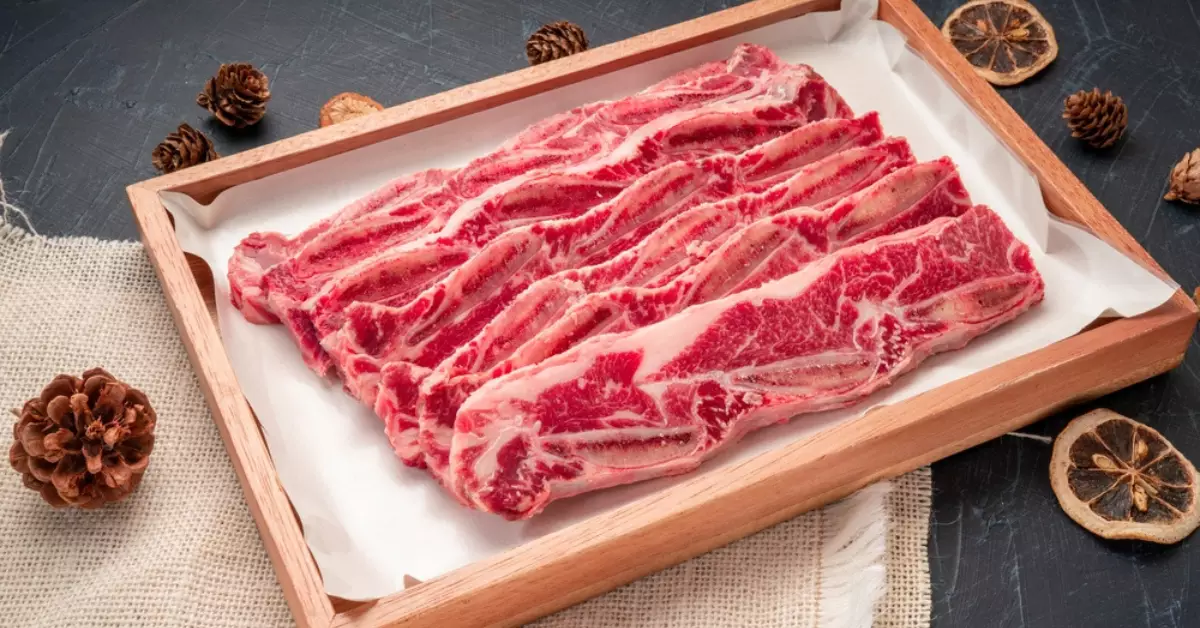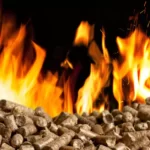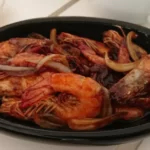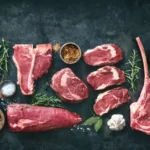A prized cut of meat revered by chefs and food connoisseurs worldwide, short ribs represent the pinnacle of comfort food. Delectably tender and rich in flavor, these ribs often steal the spotlight in diverse cuisines, from classic American barbecue to the succulent Korean Galbi.
Short ribs might indeed be fatty, but they’re part of their inherent charm. The marbling – the intricate pattern of fat intertwined with the muscle – ensures a melt-in-your-mouth experience when cooked right. Therefore, it isn’t surprising that this particular cut is so sought after by meat lovers.
However, questions about its fat content frequently surface. People are increasingly health-conscious, and fat, especially saturated fat, has been in the line of nutritional fire. So, are short ribs fatty? Yes, but it’s a bit more complicated than a simple yes or no.
Anatomy of Short Ribs
Overview of Short Rib Location on the Animal
Short ribs come from the brisket, chuck, plate, or rib areas of cattle. They consist of a short portion of the rib bone, hence the name, along with meat that varies in thickness.
Tissue Composition of Short Ribs
Like other cuts, short ribs are composed of muscle, connective tissue, and fat. The distribution of these components contributes to their texture and flavor. Notably, the amount of intramuscular fat or marbling is an indicator of the meat’s tenderness and taste profile.
Analyzing the Fat Content in Short Ribs
Understanding the fat content in short ribs requires not only looking at the raw facts and numbers but also considering the role fat plays in enhancing the taste and texture of the ribs.
Amount of Fat in Short Ribs
At the raw numbers level, short ribs have about 26 grams of fat per 100 grams of cooked meat, according to the USDA’s FoodData Central. This number can vary slightly based on factors like cooking methods and the exact cut of the ribs.
To put this into perspective, consider that each gram of fat contains nine calories. Therefore, for a serving of 100 grams, nearly 234 calories come from fat alone. In terms of daily intake, based on a 2000 calorie diet, this constitutes about 36% of the recommended maximum daily intake of fat.
It’s worth noting that of the total fat in short ribs, about 11 grams are saturated fats, which health organizations generally recommend limiting due to their potential impact on heart health.
Comparisons to Other Cuts of Meat
When compared to other cuts of meat, short ribs are on the higher end of the fat spectrum. For instance:
- Skinless chicken breast: This lean cut has only about 3.6 grams of fat per 100 grams, making it a significantly leaner choice.
- Ribeye steak: Comparable to short ribs, a ribeye steak has around 25 grams of fat per 100 grams.
Remember, each type of meat and cut has its own unique flavor profile and texture, largely influenced by its fat content. While leaner cuts may be lower in fat, they often require careful cooking to prevent them from drying out.
Influence of Cooking Methods on Fat Content
The way you cook your short ribs can influence their final fat content. Different cooking methods can either render out fat or cause it to be absorbed into the sauce or cooking liquid.
Impact of Different Cooking Techniques
Different cooking techniques can have varying effects on the fat content of short ribs:
- Grilling and broiling: These high-heat methods can render out some of the fat from the ribs, resulting in a leaner end product.
- Roasting: Like grilling and broiling, roasting at high temperatures can also reduce fat content, as some fat melts and drips off the ribs.
- Braising: This slow-cooking method involves simmering the ribs in a small amount of liquid. While it can break down tough connective tissues, resulting in tender ribs, it does not significantly reduce the fat content.
Regardless of the cooking method, trimming visible fat from the ribs before cooking can also help reduce the final fat content.
Role of Slow Cooking and Braising on Fat
Braising and slow cooking are popular methods for cooking short ribs. These techniques involve long cooking times at lower temperatures, which can turn tough, fatty short ribs into melt-in-your-mouth delights. Here’s how they impact fat content:
- Breaking down connective tissue: The long, slow cooking process breaks down the tough connective tissue in the ribs, making them incredibly tender. However, this does not necessarily reduce fat content.
- Fat melts into the sauce: As the ribs cook, much of their fat melts into the sauce or cooking liquid. This can make the sauce incredibly flavorful, but also high in fat.
If you’re concerned about the fat content, one strategy is to refrigerate the cooking liquid after braising. As it cools, the fat will rise to the top and solidify, making it easy to remove before reheating the ribs and sauce.
Health Aspects of Consuming Short Ribs
While short ribs are higher in fat, they also provide significant nutritional value, contributing to a balanced diet.
Nutritional Information
Apart from fat, short ribs provide several other nutrients:
- Protein: Short ribs are an excellent source of protein, with about 29 grams per 100-gram serving.
- Vitamins and minerals: They offer essential nutrients like iron, zinc, and vitamin B12.
- Calories: With approximately 348 calories per 100 grams, short ribs are a calorie-dense food.
As always, these nutritional benefits should be weighed against the relatively high fat and calorie content. Portion control and balance with other food groups are key when including short ribs in your diet.
Considerations for Dietary Restrictions
For individuals on low-fat or heart-healthy diets, it’s important to note that short ribs, like all cuts of meat, contain cholesterol. If your doctor has advised you to watch your cholesterol levels, you may need to limit your consumption of short ribs and other high-fat meats.
If you have other dietary restrictions or preferences, such as a plant-based diet, there are many meat alternatives available that can mimic the texture and flavor of short ribs. Some of these plant-based proteins can be prepared using similar cooking techniques, like braising, to achieve a similar end result.
However, if you love short ribs and want to continue enjoying them while maintaining a balanced diet, there are ways to do so, as discussed in the following sections.
Strategies to Reduce Fat in Short Ribs
Choosing Leaner Cuts
While you can’t alter the intrinsic fat content of short ribs, choosing leaner cuts of meat can help you manage your fat intake. For instance, cuts like round steak and skinless chicken breast have significantly less fat.
Cooking Tips for Less Fat
Altering your cooking method can also impact the final fat content of your meal. Opting for grilling, broiling, or roasting can help render out some fat. Moreover, chilling the meat after cooking allows the fat to solidify on the surface, making it easier to skim off.
Short Ribs in Low-Fat and Balanced Diets
Incorporating Short Ribs in Healthy Meals
Including short ribs in a balanced diet isn’t impossible. Pairing them with fiber-rich vegetables and whole grains can create a satisfying meal. Just remember to keep portion sizes in check to avoid excess fat and calorie intake.
Expert Tips for Balanced Eating
Experts advise adopting an inclusive approach to nutrition. Rather than completely avoiding certain foods, like fatty cuts of meat, moderating intake is key. Consuming a diverse diet rich in whole foods and limiting processed foods can promote overall health.
Frequently Asked Questions
Are short ribs unhealthy due to their high fat content?
While short ribs have a higher fat content compared to leaner cuts, they can be part of a balanced diet when consumed in moderation. They also provide essential nutrients like protein, vitamins, and minerals.
Can cooking methods reduce the fat content in short ribs?
Certain cooking methods like grilling, broiling, or roasting can render out some fat from the ribs. Additionally, chilling cooked ribs allows the fat to solidify on the surface, making it easy to remove.
Are there leaner alternatives to short ribs?
Yes, cuts like round steak, skinless chicken breast, or turkey are leaner alternatives. However, each type of meat offers a unique flavor and texture, so choose according to your preferences and dietary needs.
Conclusion
Summing up, yes, short ribs are fatty. Yet, the intricate blend of meat and fat is precisely what lends short ribs their beloved flavor and texture. While their fat content can seem intimidating, especially to the health-conscious, it’s essential to remember the role of balance and moderation.
Cooking techniques can somewhat influence the final fat content, and pairing short ribs with healthier sides can create a balanced meal. But if your diet requires lower fat intake, there are plenty of leaner cuts to explore.
As with all things food-related, the key lies in making informed choices. Knowledge about the nutritional profile of short ribs allows you to incorporate them into your diet in a way that aligns with your health and flavor preferences. After all, in the culinary world, understanding and appreciating the essence of each ingredient is part of the joy of eating.







